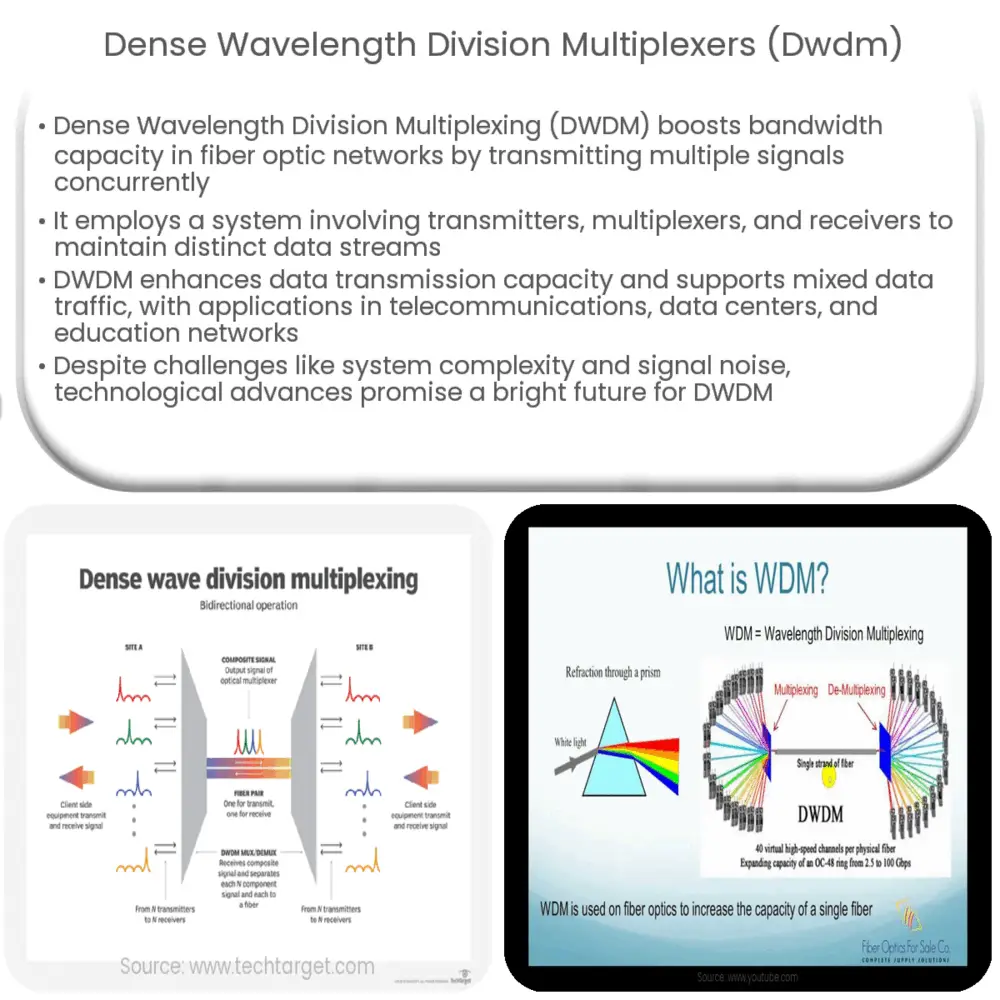Explore the role of Dense Wavelength Division Multiplexing (DWDM) in boosting network capacity, its applications, challenges, and future prospects.

Introduction to Dense Wavelength Division Multiplexers (DWDM)
Dense Wavelength Division Multiplexing (DWDM) is a technology that significantly increases the bandwidth capacity of fiber optic networks. DWDM achieves this feat by simultaneously transmitting multiple signals over the same fiber strand using different wavelengths or colors of light. In the digital communication landscape, it plays a critical role by providing an effective and efficient means to accommodate the ever-growing demand for network capacity.
How Does DWDM Work?
DWDM works on the principle of transmitting multiple data signals on the same fiber optic cable using different wavelengths of light. Each data stream is assigned to a distinct light frequency within the infrared region. This process, known as multiplexing, enables a single optical fiber to carry several signals at once.
The DWDM technology is able to maintain separate, concurrent streams of data without the risk of overlap or interference between signals, thanks to the specific wavelengths assigned to each signal. This independence of data streams allows a tremendous increase in the total network capacity, turning a single fiber cable into a conduit for potentially dozens or even hundreds of simultaneous communications.
Components of a DWDM System
- Transmitter: The transmitter is an assembly of lasers that produce light signals. Each laser generates a signal at a unique wavelength, representing a particular data channel.
- Multiplexer: This component combines the multiple signals from the transmitters into a single, complex signal that can be sent over a fiber optic cable.
- Fiber optic cable: The cable serves as the medium for transmitting the complex signal over long distances.
- Demultiplexer: At the receiving end, the demultiplexer separates the complex signal back into its original, separate data signals.
- Receiver: Finally, the receivers take the individual signals and convert the light data back into the original form, whether it be digital data, voice, or other formats.
Benefits of DWDM
DWDM offers several advantages in the field of data communication. Primarily, it dramatically increases the capacity of data transmission. Additionally, it provides flexibility and scalability, allowing networks to expand capacity without overhauling the entire infrastructure. Lastly, the technology also supports different transmission protocols, which can be transmitted across the same fiber, offering robust support for mixed data traffic.
Applications of DWDM
Due to its significant capacity-boosting abilities, DWDM has found a myriad of applications in today’s network-dependent world. Here are a few prominent ones:
- Telecommunications: Telecommunication companies use DWDM to provide high-speed data services such as broadband and mobile data. By expanding their network capacity, they can deliver better service to a greater number of customers.
- Data Centers: DWDM is used in data centers to connect servers and storage devices. It enables fast, reliable data transfer, which is essential for real-time applications and cloud services.
- Cable TV: Cable TV providers use DWDM to deliver multiple channels over a single fiber, offering customers a wider range of viewing options.
- Research and Education Networks: Educational and research institutions leverage DWDM to create high-capacity network connections, enabling collaborative projects and remote learning opportunities.
Challenges and Future of DWDM
Despite its remarkable advantages, implementing a DWDM system comes with its own set of challenges. The system’s complexity, initial setup costs, and need for specialized skills can be barriers for some organizations. Additionally, as the number of channels increase, managing signal noise and interference becomes more challenging.
Nonetheless, DWDM technology is continuously evolving, and advancements are being made to address these issues. With ever-increasing demand for data and new applications emerging, the future of DWDM appears promising. Innovations in this field aim to further enhance the technology’s capacity, efficiency, and accessibility.
Conclusion
In conclusion, Dense Wavelength Division Multiplexing (DWDM) has revolutionized data transmission by significantly enhancing the bandwidth capacity of fiber optic networks. Through its ability to transmit multiple data signals concurrently, it offers a solution to the escalating demand for network capacity. Its applications are extensive, and despite certain challenges, ongoing technological developments indicate a bright future for DWDM. As data consumption continues to surge, the importance of this technology will undoubtedly remain paramount in the era of digital communication.

